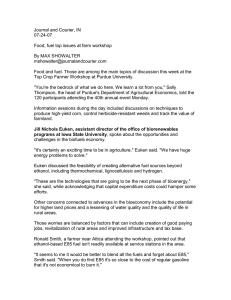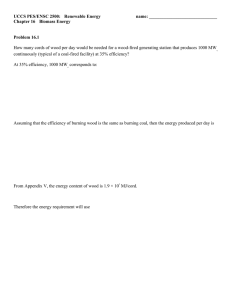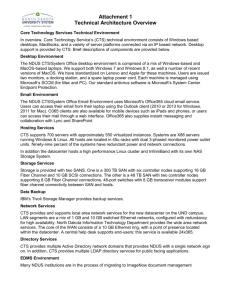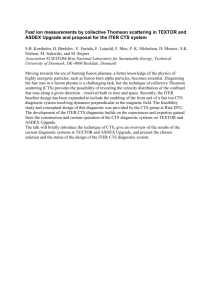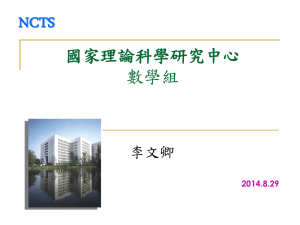CHAPTER 3 PERFORMANCE
advertisement
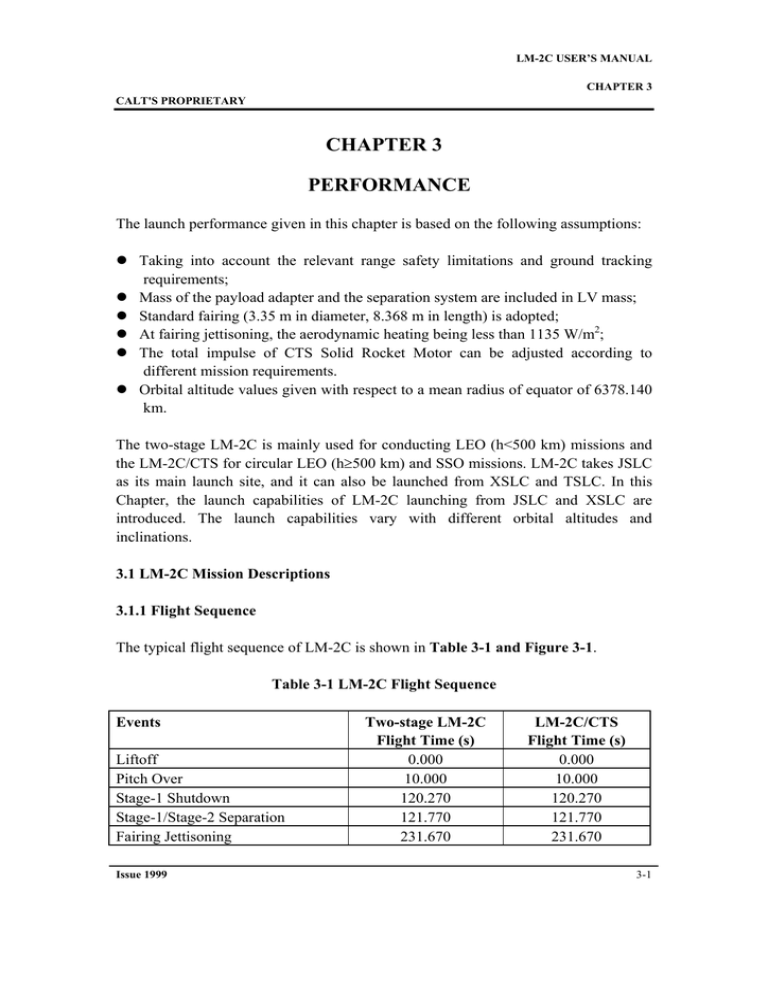
LM-2C USER’S MANUAL CHAPTER 3 CALT'S PROPRIETARY CHAPTER 3 PERFORMANCE The launch performance given in this chapter is based on the following assumptions: z Taking into account the relevant range safety limitations and ground tracking requirements; z Mass of the payload adapter and the separation system are included in LV mass; z Standard fairing (3.35 m in diameter, 8.368 m in length) is adopted; z At fairing jettisoning, the aerodynamic heating being less than 1135 W/m2; z The total impulse of CTS Solid Rocket Motor can be adjusted according to different mission requirements. z Orbital altitude values given with respect to a mean radius of equator of 6378.140 km. The two-stage LM-2C is mainly used for conducting LEO (h<500 km) missions and the LM-2C/CTS for circular LEO (h≥500 km) and SSO missions. LM-2C takes JSLC as its main launch site, and it can also be launched from XSLC and TSLC. In this Chapter, the launch capabilities of LM-2C launching from JSLC and XSLC are introduced. The launch capabilities vary with different orbital altitudes and inclinations. 3.1 LM-2C Mission Descriptions 3.1.1 Flight Sequence The typical flight sequence of LM-2C is shown in Table 3-1 and Figure 3-1. Table 3-1 LM-2C Flight Sequence Events Liftoff Pitch Over Stage-1 Shutdown Stage-1/Stage-2 Separation Fairing Jettisoning Issue 1999 Two-stage LM-2C Flight Time (s) 0.000 10.000 120.270 121.770 231.670 LM-2C/CTS Flight Time (s) 0.000 10.000 120.270 121.770 231.670 3-1 LM-2C USER’S MANUAL CHAPTER 3 CALT'S PROPRIETARY Stage-2 Main Engine Shutdown Stage-2 Vernier Engine Shutdown Stage-2/CTS Separation CTS Solid Rocket Motor Ignition Beginning of Terminal Velocity Adjustment SC/LV Separation CTS Deorbit Issue 1999 305.770 566.234 / / / 301.184 613.333 616.333 2888.347 2928.347 569.234 / 3013.347 3213.347 3-2 LM-2C USER’S MANUAL CALT'S PROPRIETARY CHAPTER 3 2 1 3 4 5 6 7 8 Figure 3-1 LM-2C/CTS Flight Sequence 9 10 11 12 1. Liftoff 2. Pitch Over 3. Stage-1 Engine Shutdown 4. Stage-1/Stage-2 Separation 5. Fairing Jettison 6. Stage-2 Main Engine Shutdown 7. Stage-2 Veriner Engine Shutdown 8. Stage-2/CTS Separation 9. CTS Solid Rocket Motor Ignition 10. Beginning of Terminal Velocity Adjustment 11. SC/LV Separation 12. CTS Deorbit 3-3 3-3 Issue 1999 LM-2C USER’S MANUAL CHAPTER 3 CALT'S PROPRIETARY 3.1.2 LM-2C/CTS Characteristic Parameters The characteristic parameters of typical LM-2C/CTS trajectory are shown in Table 3-2. The flight acceleration, velocity, Mach numbers and altitude vs. time are shown in Figure 3-2a&b. Table 3-2 Characteristic Parameters of Typical Trajectory Relative Flight Ground Ballistic SC SC Velocity Altitude Distance Inclination projection projection (m/s) 0.2 (km) 1.452 (km) 0 (°) 90 Latitude (°) 38.661 Longitude(°) 111.608 2035.853 47.052 61.755 22.765 38.106 111.633 2043.777 48.257 64.549 22.403 38.081 111.635 3698.167 117.618 352.768 4.263 35.490 111.729 6379.424 146.895 679.624 -2.540 32.551 111.813 7917.684 181.142 2825.723 -25.629 13.252 112.076 7918.657 181.104 2848.800 -25.829 13.045 112.077 CTS SRM Ignition 7402.700 637.804 18860.013 -173.727 -44.220 -80.123 Terminal Velocity 7512.356 639.455 18971.228 -177.295 -41.780 -80.001 7520.725 637.611 18983.402 177.366 -36.557 -79.808 Event Liftoff Stage-1 Shutdown Stage-1/Stage-2 Separation Fairing Jettisoning Stage-2 Main Engine Shutdown Stage-2 Vernier Engine Shutdown Stage-2/CTS Separation Adjustment Ending SC/LV Separation Issue 1999 3-4 LM-2C USER’S MANUAL CHAPTER 3 CALT'S PROPRIETARY Nx(g) V(m/s) Flight Time (s) Flight Velocity 8 8000 6 6000 4 4000 2 2000 Longitudinal Acceleration 0 0 0 1000 2000 3000 4000 Flight Time (s) Figure 3-2a LM-2C/CTS Flight Acceleration and Flight Velocity vs. Flight Time M H(km) 700 14 Mach Number Flight Altitude 600 12 500 10 400 8 300 6 200 4 100 2 0 0 0 1000 2000 3000 4000 Figure 3-2b LM-2C/CTS Flight Altitude and Mach Numbers vs. Flight Time Issue 1999 3-5 LM-2C USER’S MANUAL CHAPTER 3 CALT'S PROPRIETARY 3.2 Launch Capacities 3.2.1 Basic Information on Launch Sites z Jiuquan Satellite Launch Center (JSLC) Two-stage LM-2C and LM-2C/CTS conduct LEO and SSO missions from Jiuquan Satellite Launch Center (JSLC), which is located in Gansu Province, China. The geographic coordinates are listed as follows: Latitude: Longitude: Elevation: z 40.96°N 100 .29°E 1072m Xichang Satellite Launch Center (XSLC) Two-stage LM-2C and LM-2C/CTS conduct LEO missions from Xichang Satellite Launch Center (XSLC), which is located in Sichuan Province, China. The geographic coordinates are listed as follows: Latitude: Longitude: Elevation: 28.2°N 102.02°E 1826m 3.2.2 Two-stage LM-2C Mission Performance The launch capacity of Two-stage LM-2C for typical LEO mission (h=200km, i=63°) is 3366kg. The different LEO launch capabilities vs. different inclinations and apogee altitudes are shown in Figure 3-3a,b,c&d. Issue 1999 3-6 LM-2C USER’S MANUAL CHAPTER 3 CALT'S PROPRIETARY SC Mass (kg) 3600 A 3400 B A- B- C- D- i=50deg i=63deg i=86deg SSO 3200 3000 C 2800 D 2600 2400 2200 2000 1800 200 250 300 350 400 Circular Orbit Altitude (km) Figure 3-3a Two-stage LM-2C’s Capability for Circular Orbit Missions (From JSLC) Launch Capability (kg) 3400 A: hp=200 km B: hp=300 km C: hp=400 km Inclination=63 A 3200 3000 B 2800 2600 C 2400 2200 2000 1800 1600 0 500 1000 1500 2000 Apogee Altitude (km) Figure 3-3b Two-stage LM-2C’s Capability for Elliptical Orbit Missions (From JSLC) Issue 1999 3-7 LM-2C USER’S MANUAL CHAPTER 3 CALT'S PROPRIETARY Launch Capability (kg) 4200 A 4000 A: hp=200 km B: hp=300 km C: hp=400 km Inclination=29 3800 B 3600 3400 3200 C 3000 2800 2600 2400 2200 0 400 800 1200 1600 2000 Apogee Altitude (km) Figure 3-3c Two-stage LM-2C’s Capability for Elliptical Orbit Missions (From XSLC) Launch Capability (kg) 3500 A: Inclination=63 (From JSLC) B: Inclination=29 (From XSLC) Hp=200 km A 3000 B 2500 2000 1500 1000 500 8000 8500 9000 9500 10000 10500 11000 Velocity at Perigee (m/s) Figure 3-3d LM-2C’s Capability for Large Elliptical Orbit Missions Note: For this kind of mission, LM-2C works as follows: After Two-stage LM-2C reach the parking orbit (a LEO), it will release a solid upper stage and spin it up Issue 1999 3-8 LM-2C USER’S MANUAL CHAPTER 3 CALT'S PROPRIETARY according to required direction. Then the upper stage will go into the large elliptical transit orbit by ignition at the pre-determined time. The method is suitable for GTO or Earth escape missions. The solid upper stage for orbit maneuvering can be made according to user’s specific requirements. 3.2.3 LM-2C/CTS Mission Performance The launch capacity of LM-2C/CTS for typical LEO mission (h=500 km, i=50°) is 3000 kg. The different LEO and SSO launch capabilities vs. different inclinations and apogee altitudes are shown in Figure 3-4a&b. SC Mass (kg) A- B- C- D- E- F- G- H- 3000 2800 2600 2400 i=50deg i=50deg Deorbit i=63deg i=63deg Deorbit i=86deg i=86deg Deorbit SSO SSO Deorbit 2200 2000 A B C D 1800 1600 1400 E F G H 1200 1000 200 400 600 800 1000 1200 1400 1600 Circular Orbit Altitude (km) Figure 3-4a LM-2C/CTS’s Capability for Circular Orbit Missions (From JSLC) Issue 1999 3-9 LM-2C USER’S MANUAL CHAPTER 3 CALT'S PROPRIETARY SC Mass (kg) 3500 A: i=29 deg B: i=29 deg Deorbit C: SSO D: SSO Deorbit 3000 2500 A B 2000 1500 C D 1000 200 400 600 800 1000 1200 1400 1600 Circular Orbit Altitude (km) Figure 3-4b LM-2C/CTS’s Capability for Circular Orbit Missions (From XSLC) Issue 1999 3-10 LM-2C USER’S MANUAL CHAPTER 3 CALT'S PROPRIETARY 3.3 Injection Accuracy 3.3.1 Two-stage LM-2C Injection Accuracy The injection accuracy is different for the different missions. The injection accuracy for elliptical LEO (hp=200km, ha=400km) mission is shown in Table 3-3 and Table 3-4. Symbol ∆a ∆e ∆i ∆Ω ∆ω Table 3-3 Injection Accuracy for LEO Mission (hp=200km, ha=400km) Parameters Deviation (1σ) Semi-major Axis 1.1 km Eccentricity 0.00022 Inclination 0.045 deg. Right Ascension of Ascending Node 0.055 deg. Perigee Argument 1.67 deg. Table 3-4 Covariance Matrix of Injection for LEO Mission (hp=200km, ha=400km) a e i a e i Ω ω 1.210 1.154E-4 4.840E-8 -8.821E-3 -3.086E-6 2.025E-3 2.202E-2 9.622E-6 -3.044E-4 3.025E-3 6.319E-1 1.564E-4 7.823E-3 2.172E-2 Ω ω 2.789 3.3.2 LM-2C/CTS Injection Accuracy The injection accuracy for the circular orbit mission (h=630km) is shown in Table 3-5. Table 3-5 Injection Accuracy for Circular Orbit Mission (h=630km) Symbol ∆h ∆i ∆Ω Issue 1999 Parameters Orbital Altitude Inclination Right Ascension of Ascending Node Deviation (1σ) 6 km 0.05 deg. 0.06 deg. 3-11 LM-2C USER’S MANUAL CHAPTER 3 CALT'S PROPRIETARY 3.4 Separation Accuracy 3.4.1 Two-stage LM-2C Separation Accuracy The separation accuracy of Two-stage LM-2C is shown in Table 3-6. Table 3-6 Two-stage LM-2C Separation Accuracy (1σ) Items Roll Angular Rates ωx Separation Accuracy <0.5°/s Yaw Angular Rates ωy <1.1°/s Pitch Angular Rates ωz Pitch Yaw Roll <1.1°/s <3.2° <3.2° <1.5° 3.4.2 LM-2C/CTS Separation Accuracy The separation accuracy of LM-2C/CTS is shown in Table 3-7. Table 3-7 LM-2C/CTS Separation Accuracy (1σ) Items Roll Angular Rates ωx Separation Accuracy <0.3°/s Yaw Angular Rates ωy <0.3°/s Pitch Angular Rates ωz Pitch Yaw Roll <0.3°/s <0.6° <0.6° <0.6° 3.5 Launch Windows LM-2C adopts automatic timing ignition, and it can be launched in zero-launch window. Issue 1999 3-12
